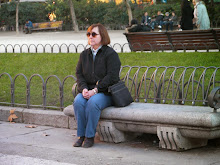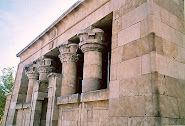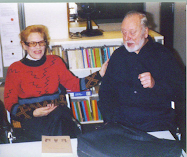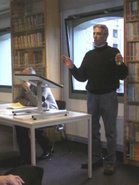 Found at this German website:
http://www.erdwerk-archaeologie.de/vortraege.html
What is it (for instance, a tombstone)? Where does it come from? Provenance? How old? Are those runes carved into the serpent's back? If they are runes, can anyone read them and translate them for me?
Gee, I don't want too much, do I. LOL!
Found at this German website:
http://www.erdwerk-archaeologie.de/vortraege.html
What is it (for instance, a tombstone)? Where does it come from? Provenance? How old? Are those runes carved into the serpent's back? If they are runes, can anyone read them and translate them for me?
Gee, I don't want too much, do I. LOL!
Thursday, January 7, 2010
Need Help Identifying This Image
 Found at this German website:
http://www.erdwerk-archaeologie.de/vortraege.html
What is it (for instance, a tombstone)? Where does it come from? Provenance? How old? Are those runes carved into the serpent's back? If they are runes, can anyone read them and translate them for me?
Gee, I don't want too much, do I. LOL!
Found at this German website:
http://www.erdwerk-archaeologie.de/vortraege.html
What is it (for instance, a tombstone)? Where does it come from? Provenance? How old? Are those runes carved into the serpent's back? If they are runes, can anyone read them and translate them for me?
Gee, I don't want too much, do I. LOL!
Maltese Historian Shut Out of Credit for Discovery
Why? That's what I want to know. What's going on here - what is the story behind this story for such crappy treatment of Mr. Tabone? Whatever it is, shame SHAME on these people who shut him out of receiving the credit that he deserves.
Wednesday, 06 January 2010
Megalithic spin? Brockdorff Circle report literally rewrites history
Raphael Vassallo
The long-awaited official report into the excavations of the Gozo Stone (aka Brockdorff) Circle in Xaghra – a unique underground prehistoric burial site near Ggantija temples – may have rewritten Maltese history in more ways than one: by failing to properly acknowledge that the site was originally discovered by Gozitan historian Joseph Attard Tabone, whose extensive research led to its precise relocation in 1965.Launched yesterday at the Gozo Ministry, Victoria, and edited by Caroline Malone – wife of archaeologist Prof. David Trump, who oversaw the initial excavations – the 521-page volume purports to be an exhaustive collection of articles and papers related to this unique underground Neolithic burial complex.
Among the contributors are: Caroline Malone; Prof. Trump; Prof. Anthony Bonanno (Malta); Prof. Simon Stoddard (Cambridge); former Archaeology Curator Tancred Gouder; and the Superintendent of Cultural Heritage, Anthony Pace.
But a seminal paper written by Attard Tabone in 1965, detailing the precise circumstances of the burial site’s discovery, was neither included nor even mentioned in the entire book.
Instead, the official report into the history of the Brockdorff Circle appears to have minimised Attard Tabone’s entire contribution to its discovery – limiting its only allusion to a single, fleeting line in Chapter 1 (page 5) – while concentrating almost entirely on the contributions of the Trump-led excavations from 1965 onwards.
And yet it was Attard Tabone who first alerted Trump to the discovery of three previously unidentified menhirs (standing stones) in a farmer’s rubble wall in 1959; and it was also Attard Tabone who later understood the significance of the find, recognising them as the only external remnants of a stone circle that had been described in historical writings, but subsequently lost.
“In 1959 I reported this megalithic wall to Dr David Trump, then Curator of Archaeology,” Mr Attard Tabone said in a 2002 interview with journalist Karl Schembri. “We inspected the site together and he included it in the 1959/60 Museum Report; but we did not realise then, that under our feet lay a great wealth of archaeological material and that this wall was part of the Gozo Stone Circle. The secrets of the site were still hidden in libraries, archives and underground.”It took Attard Tabone another five years to identify the site as part of the lost underground ruin, having established the location through visual evidence in the form of an 18th century illustration by French artist and writer, Jean Houel.
Attard Tabone wrote about his discoveries in 1965, detailing the research and surface observations that led him to identify this field as the site of the complex later named the ‘Brockdorff Circle’.
But he limited his contribution only to making public the exact location, leaving the actual excavation to professional archaeologists.
Surprisingly, however, his crucial paper was ignored altogether by a report supposedly detailing the discovery and excavations of this unique site. Furthermore, the rubble wall in question is passed off in the text as a recent discovery, when in fact there are no fewer than three mentions in Attard Tabone’s historic 1965 paper.
To add insult to injury, Attard Tabone himself was not even included in the list of official acknowledgements: only mentioned very casually in a single sentence of the introductory chapter.
“How do I feel about it? Hurt, mostly,” an aggrieved Attard Tabone said when contacted yesterday. “After all that hard work - not just to discover the monument, but also to conserve it: I have had to put up with years of abuse by builders who would willingly have reduced it all to rubble, if they had their own way.... And then, after all this, to be left out completely... it’s a great disappointment.”
Attard Tabone, who was awarded the Gieh ir-Repubblika medal in 2002 for his outstanding contribution to Maltese history and archaeology, did not attend yesterday’s launch (for though he was omitted from the acknowledgments, he still received an invitation).
His absence did not pass unnoticed, and four of the books’ contributors – including its editor, Caroline Malone – took the initiative to pay him a visit at his residence in Gozo afterwards, to hand him an autographed copy of the book.
“Their handwritten dedication does acknowledge me as the discoverer of the Gozo Stone Circle,” he confirmed yesterday; but while he admitted that this gesture, which took him completely by surprise, “changes things slightly”, he remains disappointed at the fact that official history left him out of its calculations insofar as the Brockdorff Circle is concerned.
Efforts to contact Ms Malone through the offices of Heritage Malta proved futile all day yesterday.
An interview with Joseph Attard Tabone from (I believe) 2005 highlights the clash between "developers" and preservationists (such as Mr. Tabone) -- could money possibly have anything to do with the petty treatment of Mr. Tabone's contributions to Maltese archaeology by the authors of the "official" report on the Gozo Stone Circle?
 I found this image, ironically enough, in a summary of a "pod" lecture description page (Queen's University, Belfast), lecturer: Caroline Malone (see above) identified as: Brochtorff Circle, Gozo Malta -figurine PAIR.
Note: I also saw Brockdorff spelled Brochtorff, and also identified as the Xagħra Stone Circle, although the Brochtorff Circle is the second one discovered there, and as I understand it (doing on the fly research), Brochtroff is the younger of the two circles.
I found this image, ironically enough, in a summary of a "pod" lecture description page (Queen's University, Belfast), lecturer: Caroline Malone (see above) identified as: Brochtorff Circle, Gozo Malta -figurine PAIR.
Note: I also saw Brockdorff spelled Brochtorff, and also identified as the Xagħra Stone Circle, although the Brochtorff Circle is the second one discovered there, and as I understand it (doing on the fly research), Brochtroff is the younger of the two circles.
 I found this image, ironically enough, in a summary of a "pod" lecture description page (Queen's University, Belfast), lecturer: Caroline Malone (see above) identified as: Brochtorff Circle, Gozo Malta -figurine PAIR.
Note: I also saw Brockdorff spelled Brochtorff, and also identified as the Xagħra Stone Circle, although the Brochtorff Circle is the second one discovered there, and as I understand it (doing on the fly research), Brochtroff is the younger of the two circles.
I found this image, ironically enough, in a summary of a "pod" lecture description page (Queen's University, Belfast), lecturer: Caroline Malone (see above) identified as: Brochtorff Circle, Gozo Malta -figurine PAIR.
Note: I also saw Brockdorff spelled Brochtorff, and also identified as the Xagħra Stone Circle, although the Brochtorff Circle is the second one discovered there, and as I understand it (doing on the fly research), Brochtroff is the younger of the two circles.
Oldest Yet Hebrew Inscription Deciphered
From Archaeology News aggregagtor
Archaeologists claim discovery of oldest Hebrew writing
Thu Jan 07 2010
JERUSALEM (AFP) --
A 3,000 year-old inscription discovered at a site where the Bible says David slew Goliath has been deciphered, showing it to be the earliest known Hebrew writing, Israeli archaeologists said on Thursday.
The pottery shard with five lines of text in the proto-Canaanite script that was used by Hebrews, Philistines and others in the region was discovered 18 months ago.
The writing was decrypted by Gershon Galil of the University of Haifa who "has shown this is a Hebrew inscription," said a statement from the university.
"The discovery makes it the earliest known Hebrew writing," the statement said.
Carbon-dating has shown the inscription dates back to the 10th century BC, making it about 1,000-years older than the Dead Sea scrolls.
"This text is a social statement, relating to slaves, widows and orphans," said Galil, adding that both the words and the concepts used were specific to the Hebrew language and society.
The shard was found near the gate of a site known as Elah Fortress, about 30 kilometres (18 miles) west of Jerusalem, in the valley where the battle between David and Goliath is said to have taken place.
Finding such an early example of Hebrew makes it possible the Bible could have been written several centuries before the current estimates, the statement said.
"The inscription is similar in its content to biblical scriptures, but it is clear that it is not copied from any biblical text, the statement said.
Copyright © 2010 AFP All Rights Reserved
Wednesday, January 6, 2010
The Great Flood Myth
A follow-up to my Monday post "Good Stories Never Die," about the Great Flood.
Information from Barbara Walker's The Woman's Encyclopedia of Myths and Secrets:
Flood
The biblical flood story, the "deluge," was a late offshoot of a cycle of flood myths known everywhere in the ancient world. Thousands of years before the Bible was written, an ark was built by Sumerian Ziusudra. In Akkad, the flood hero's name was Atrakhasis. In Babylon he was Uta-Napishtim, the only mortal to become immortal. In Greece he was Deucalion, who repopulated the earth after the waters subsided, with the help of his wife Pyrrha and the advice of the Great Goddess of the waters, Themis. In Armenia, the hero was Xisuthros - a corruption of Sumerian Ziusudra - whose ark landed on Mount Ararat.(1)
According to the original Chaldean account, the flood hero was told by his god, "Build a vessel and finish it. By a deluge I will destroy substance and life. Cause thou to go up into the vessel the substance of all that has life." Technical instructions followed: the ark was to be 600 cubits long by 60 wide, with three times 3600 measures of asphalt on its exterior and the same amount inside. Three times 3600 porters brought chests of provisions, of which 3600 chests were for the hero's immediate family, while "the mariners divided among themselves twice three thousand six hundred chests."(2) It seems that Noah's ark was much smaller than earlier heroic proportions.
[Cubit: From Latin cubitum, "elbow"; the length of an average hand and forearm from the tip of the middle finger to the elbow (about 18-21 inches).]
As long ago as 1872, George Smith translated the Twelve Tablets of Creation from Ashurbanipal's library, and discovered he earlier version of the flood myth.(3)
[Ashurbanipal - King of Assyria c. 669-630 BC., military leader and statesman. He collected at Nineveh a large library of cuneiform texts, rediscovered by archaeologists in the 19th century A.D.]
Among the details that religious orthodoxy took care to suppress was the point that the god who caused the flood was disobedient to the Great Mother, who didn't want her earthly children drowned. Mother Ishtar severely punished the disobedient god by cursing him with her "great lightnings." She set her magic rainbow in the heavens to block his access to offerings on earthly altars, "since rashly he caused the flood-storm, and handed over my people to destruction."(4)
Old Testament writers copied other details of the ancient flood myth but could not allow their god to be punished by the Great Whore of Babylon, as if he were a naughty child sent to bed without supper by an angry mother. Thus, they transformed Ishtar's rainbow barrier into a "sign of the covenant" voluntarily set in the heavens by God himself (Genesis 9:13).
The Tigris-Euphrates valley was subject to disastrous floods. One especially was long remembered: geologists have linked it with the volcanic cataclysm that blew apart the island of Thera (Santorin) and destroyed Cretan civilization. When Sir Leonard Woolley was excavating the site of Ur, he found the track of a mighty flood - a layer of clay, without artifacts, eight feet thick.(5) [Holy crap!] Such a flood may have been identified with the watery Chaos that all Indo-European peoples believed would swallow up the world at the end of its cycle, and out of which a new world would be reborn in the womb of the Formless Mother.(6) The ark and its freight represented seeds of life passing through the period of Chaos from the destruction of one universe to the birth of the next. Even in the Bible, the "birth" was heralded by the Goddess's yonic dove (Genesis 8:12).
Gnostic literature preserved the older view of the flood-causing God as an evil destroyer of humanity, and the Goddess as its preserver. Because people refused to worship him alone, jealous Jehovah sent the flood to wipe out all life. Fortunately the Goddess opposed him, "and Noah and his family were saved in the ark by means of the sprinkling of light that proceeded from her, and through it the world was gain filled with humankind."(7)
This Gnostic interpretation had both Babylonian and Hellenic roots. Greeks said the primal sea-mother Themis gave Deucalion and his wife occult knowledge ("light") of how to create human being from stones, "the bones of their Mother," i.e., of the earth. (8) Raising up living people from stones or bones was a popular miracle. Jesus mentioned it, and Ezekiel's God claimed to have done it in the valley bones (Ezekiel 37).
Notes:
(1) Graves, G.M. 1, 142; Hooke, M.E.M., 130.
(2) Lethaby, 239.
(3) Ceram, 314.
(4) Assyr. & Bab. Lit., 357; Epic of Gilgamesh, 112.
(5) Ceram, 353.
(6) Avalon, 233.
(7) Pagels, 55.
(8) Graves, G.M. 1, 139.
Comic Book Art Glorifies Hindu Goddesses and Gods
What a great story - and from The Wall Street Journal, no less.
ARTS & ENTERTAINMENT
JANUARY 7, 2010
Hindu Gods' Avatars On the Page
By ARNIE COOPER
Los Angeles
The Los Angeles County Museum of Art may have the Western U.S.'s largest assemblage of South Asian art, but for the next several weeks the permanent collection, featuring sculptures dating back to the Bronze Age, will be supplemented by a decidedly modern art form: the comic book.
"Heroes and Villains: The Battle for Good in India's Comics" is, according to curator Julie Romain, the first show of its kind in the country. Ms. Romain, an art historian and UCLA graduate student specializing in Medieval Hindu sculpture, says the goal of the exhibit is to demonstrate how India's artistic legacy of heroic narratives and archetypes has been embraced by comic-book creators.
Consider the first image you encounter in the introductory "teaser" section of the 54-piece exhibition: a Virgin Comics cover depicting Rama, the avatar (or incarnation) of the god Vishnu, shooting what appears to be an electrically charged bow and arrow set against a scintillating orange background.
And if you take a closer look—at the fine print above the title—you'll recognize the name Deepak Chopra, who apparently isn't just focused on love, god and wrinkle-free skin. Ms. Romain says Dr. Chopra is one of the "visionaries" (his son Gotham was one of the founders), along with the Indian film producer Shekhar Kapur, responsible for "conceptualizing the idea of retelling Indian myths." Originally called Liquid Comics, the company owes its new name to an infusion of funds from Sir Richard Branson.
But enough about new-age gurus and billionaire industrialists. Best to focus on the art—which isn't difficult when you consider the next piece. It's another Virgin Comics cover, this time spotlighting the story of the female divinity Devi, the Sanskrit word for goddess. Clad in skintight black leather from neck to boots, the contemporary version of the mother goddess has been transformed into a modern-day superhero. Only unlike Wonder Woman, Devi can also be seen (albeit in more modest attire) immortalized in a ninth-century sandstone sculpture in the adjoining Gallery of South Asian Sculpture.
"This would probably be on the outside wall of a temple in a niche. It's an icon that's worshipped, but it also depicts this climactic scene in the Devi Mahatnya, the origin story of the goddess, where she conquers the evil demon Mahisha, who takes the form of a buffalo. In a way, this is like the first comic-book story," Ms. Romain says, laughing.
Whether cartoon aficionados agree is debatable, but one thing is certain: When compared to their American counterparts, Indian comics constitute an entirely different beast.
Says Ms. Romain, "I think the big difference with these comics, especially the earlier ones, is they're stories about divine heroes and deities who are part of a living tradition, which in this case is Hinduism."
This is one reason the show also includes a series of storytelling paintings, called Paithan, named for the region in central India where they originate. The 19th-century paintings in this small collection were used by traveling storytellers. "This is probably the closest parallel to the comic book, because it's a sequential narrative," Ms. Romain says.
While the LACMA exhibition focuses on the two main Hindu deities, Rama and Devi, one of the messages you'll come away with is that the comics reflect, as Ms. Romain suggests, "an extension of [Hindu] practice, culture and tradition."
Not that all of them ignore their American counterparts. For example, once in the show's main exhibition space, visitors will instantly recognize the familiar red-and-blue human arachnid portrayed in a 2004 cover from Marvel Comics' "Spider-Man: India" series.
In fact, Ms. Romain says: "You see more and more a similarity to American comic books and also a retelling of iconic American superheroes. Basically the entire story of Spider-Man and Peter Parker has been lifted and inserted into an Indian context." So instead of Peter Parker it's Pavitr Prabhakar. Aunt May becomes Auntie Maya and Mary Jane Watson is Meera Jain.
One could say the history of Indian comics has come full circle since its relatively recent beginning in the 1960s. For apart from a lone strip, "Daabu," created by Pran Kumar Sharma in the early part of that decade, Indian comics unfolded largely with reprints of "The Phantom" and "Superman." These were sold to Indian newspapers by Anant Pai, a newspaper executive credited for launching the Indian comic-book industry.
In the summer of 1967, Mr. Pai was watching a television quiz show and became disturbed because none of the contestants knew the name of Rama's mother, yet they could answer correctly a question about the Greek god Zeus. Add to that the burgeoning popularity of American comics in the subcontinent and Mr. Pai (or "Uncle Pai" as he is best known) decided it was time for India to stake its own claim to the genre.
Later that year he launched his Amar Chitra Katha (Immortal Picture Stories) line with an adventure series about Krishna. Today the company sells about three million comic-book reprints a year in more than 20 languages. Its offshoot, ACK Media, supplies a range of new media from audio books and films to mobile-phone applications. This is a far cry from the early print-only days, when the art resembled the typical Indian calendar prints from the 19th century.
A reprint of a 1975 ACK cover depicts Valmiki's Ramayana. Valmiki, an ancient poet, is believed to have written the original Ramayana in the fifth century B.C., the standard text known throughout India. For the uninitiated, the story outlines Rama's adventures, notably his quest to rescue his wife, Sita, who's been kidnapped by an evil demon, Ravana, with multiple heads.
No doubt Mr. Pai saw his endeavor not just as a moneymaker, but also as a way to educate the young. The inside cover used the slogan "The route to your roots."
Ms. Romain notes that these comics were not only used to educate Indian schoolchildren but also collected by Indians abroad who hoped to foster their foreign-born kids' connection to the myths and epics of their heritage.
"That's still happening today. I've talked to a lot of families here who say, 'Oh, I have a bunch of these in my closet that my son used to read.' That's the real draw, and that's why I think they continue to be really popular. These are being reprinted all the time."
—Mr. Cooper is a writer based in Santa Barbara, Calif.
Statues and Temple Ruins Discovered in Malaysia
Unless I missed it, I didn't see any indication of age assigned to these statues, but they seem an exciting find nonetheless:
From The Jakarta Globe Online
January 06, 2010
Ari Adji
Sacred Statue Uncovered at Site of Ancient Hindu Temple in Yogyakarta
A statue of Nandi, the sacred bull that carried the Hindu god Shiva, was discovered on Wednesday among the ruins of what is believed to be an ancient temple at an excavation site in Yogyakarta.
Indung Panca Putra, the head of the excavation team from the Yogyakarta Antiquities and Relics Conservation Agency, said the discovery of the statue, which in Hindu mythology is said to embody sexual energy and fertility, meant that the team would now continue its work until Jan. 20. A previous deadline for the excavation work had been set for Jan. 6.
“The statue is exquisite,” Indung said. “The sculpture is carved differently from other statues of Nandi. This one is not depicted as fat.” Previous discoveries at the site, which is located on the Indonesian Islamic University campus, include a statue of Ganesha, Shiva’s divine son; a linga , the symbol of worship for Shiva; and a yoni , a Hindu symbol for divine passage or birth.
“We strongly believe the temple had a roof and its pillars were made of wood or bamboo,” Indung said. He said archeologists were working under the assumption that the pillars had not been destroyed by a volcanic mudflow hundreds of years ago, but had instead been removed by people.
Indung said that the temple ruins were different from other temples found in Central Java. “We have compared what we have found to what was found in the temples of Sambisari, Gebang and Kedulan. The comparisons have led us to believe that the material used for the temple and its statues were much harder and the sculptures are far more refined,” Indung said.
The first discovery at the site, the Ganesha statue on Dec. 21, was made when the university was preparing to lay foundations for a new library. Indung said excavation machines uncovered rocks five-meters deep that resembled an ancient building complex. The conservation team, consisting of four archaeologists and four engineers, has been working ever since to find other statues. For security reasons, the campus has had to install a fence around the dig site. The archaeological find is considered vulnerable to theft, considering the historical value of the temple.
Southwest Chess Club Action!
We are due for a snow storm starting sometime between 3 and 6 a.m. tomorrow. We may get as much as 10 inches of snow, but at the moment who knows? Because of the storm's timing, everyone should be able to make it to work just fine, but coming home tomorrow evening could be a bloody nightmare, depending on how much snow falls and how quickly the city can remove it from the streets. I understand it is supposed to be fine powdery snow and the winds are going to pick up, so there will be blowing - not good.
So, Southwest Chess Club has changed the agenda for tomorrow night's action, assuming the evening isn't cancelled altogether because of the stormy weather:
Dear Chessplayers,
Due to possibly heavy snow Thursday evening, here is the revised schedule for the next four Thursdays:
(1) Tomorrow night, we will hold a 1-night event, instead of the 3-week event (now postponed by one week):
Ice Storming Swift Swiss: January 7
3-Round Swiss in Two Sections (G/30 Minutes and G/29Minutes). USCF Rated. EF: $5. (½-Point Bye availablefor only first round if requested prior to round) TD isBecker; ATD is Grochowski.
*** Please watch our website and blog on Thursday (after 2 PM), if for any reason we need to cancel the club meeting due to bad weather. At this point, the CLUB WILL MEET tomorrow night, but check
http://home.roadrunner.com/~swcc/ and/or http://swccchess.blogspot.com/
after 2 PM Thursday for any snow-cancellation news.
(2) Next week, we are starting the "Ice on Lake Michigan Swiss" (originally planned for tomorrow night): Ice on Lake Michigan Swiss: January 14, 21, & 28 (note NEW DATES) 3-Round Swiss in Two Sections (Open and U1600).Game/100 minutes. USCF Rated. EF: $5. (One ½-PointBye Available for any round (except round three) if requestedat least 2-days prior to round). TD is Grochowski; ATD is Becker.
Next Thursday, we plan to start promptly at 7:00 p.m. Registration is 6:30-6:55 p.m. We will close the registration at 6:55. If you arrive after first-round pairings are prepared, you will have to take a 1/2-point bye in the first round. However, if you want to play but anticipate being a few minutes late, please e-mail Robin (robin.grochowski@quarles.com) or Allen (allenbecker@wi.rr.com), or call Robin (414-744-4872 or 414-861-2745) prior to 5:30 p.m. on January 14, so we can include you in the pairings. If you need a first round bye please let Robin or Allen know as soon as possible and you can have one. (Anyone who requested a 1st-round bye, please let us know if that is still true, due to the postponed start of the event).
Tuesday, January 5, 2010
Canadian-Carved Goddess of Mercy to Visit Vietnam
 Goddess of Mercy jade statue to visit Vietnam
15:18' 05/01/2010 (GMT+7)
VietNamNet Bridge – The giant statue of the Goddess of Mercy, which is made from the largest jade block in the world, will be brought to Vietnam in mid-January 2010.
The 1.1m high, 285kg statue is sculpted from the largest jade block in the world in Canada. In 2008, part of this jade block was used to make a Buddha statue of 2.7m high, 4 tonnes in weight.
The Goddess of Mercy statue will appear at the Chiang Rai pagoda in Thailand on January 15. It will also appear afterwards at a great celebration held by the Thai royal family in Bangkok. The statue will then be brought to the Quan The Am pagoda in Danang on January 19.
From January to April, the statue will go to Hanoi, HCM City, Hai Duong, Nghe An, Ha Tinh and Quang Binh.
Goddess of Mercy jade statue to visit Vietnam
15:18' 05/01/2010 (GMT+7)
VietNamNet Bridge – The giant statue of the Goddess of Mercy, which is made from the largest jade block in the world, will be brought to Vietnam in mid-January 2010.
The 1.1m high, 285kg statue is sculpted from the largest jade block in the world in Canada. In 2008, part of this jade block was used to make a Buddha statue of 2.7m high, 4 tonnes in weight.
The Goddess of Mercy statue will appear at the Chiang Rai pagoda in Thailand on January 15. It will also appear afterwards at a great celebration held by the Thai royal family in Bangkok. The statue will then be brought to the Quan The Am pagoda in Danang on January 19.
From January to April, the statue will go to Hanoi, HCM City, Hai Duong, Nghe An, Ha Tinh and Quang Binh.
More on "Lost" Pre-Hispanic Amazon Civllizations
Modern satellite technology is revealing astounding things in what's left of the Amazonian forests.
"Lost" Amazon Complex Found; Shapes Seen by Satellite
John Roach
for National Geographic News
January 4, 2010
Hundreds of circles, squares, and other geometric shapes once hidden by forest hint at a previously unknown ancient society that flourished in the Amazon, a new study says.
Satellite images of the upper Amazon Basin taken since 1999 have revealed more than 200 geometric earthworks spanning a distance greater than 155 miles (250 kilometers).
Now researchers estimate that nearly ten times as many such structures—of unknown purpose—may exist undetected under the Amazon's forest cover.
At least one of the sites has been dated to around A.D. 1283, although others may date as far back as A.D. 200 to 300, said study co-author Denise Schaan, an anthropologist at the Federal University of Pará in Belém, Brazil.
The discovery adds to evidence that the hinterlands of the Amazon once teemed with complex societies, which were largely wiped out by diseases brought to South America by European colonists in the 15th and 16th centuries, Schaan said.
Since these vanished societies had gone unrecorded, previous research had suggested that soils in the upper Amazon were too poor to support the extensive agriculture needed for such large, permanent settlements.
"We found that this picture is wrong," Schaan said. "And there is a lot more to discover in these places."
Wide-reaching Culture
The newfound shapes are created by a series of trenches about 36 feet (11 meters) wide and several feet deep, with adjacent banks up to 3 feet (1 meter) tall. Straight roads connect many of the earthworks.
Preliminary excavations at one of the sites in 2008 revealed that some of the earthworks were surrounded by low mounds containing domestic ceramics, charcoal, grinding-stone fragments, and other evidence of habitation.
But who built the structures and what functions they served remains a mystery. Ideas range from defensive buildings to ceremonial centers and homes, the study authors say.
Rest of article.
New Method for DNA Sequencing Ancient Human Bones
 From BBC News
DNA analysed from early European
By Paul Rincon Science reporter, BBC News
Scientists have analysed DNA extracted from the remains of a 30,000-year-old European hunter-gatherer.
Studying the DNA of long-dead humans can open up a window into the evolution of our species (Homo sapiens). But previous studies of this kind have been hampered by scientists' inability to distinguish between the ancient human DNA and modern contamination.
In Current Biology journal, a German-Russian team details how it was possible to overcome this hurdle.
Svante Paabo, from the Max Planck Institute for Evolutionary Anthropology in Leipzig, Germany, and colleagues used the latest DNA sequencing techniques to study genetic information from human remains unearthed in 1954 at Kostenki, Russia.
Excavations at Kostenki, on the banks of the river Don in southern Russia, have yielded large concentrations of archaeological finds from the Palaeolithic (roughly 40,000 years ago to 10,000 years ago). Some of the finds date back as far as 45,000 years.
The DNA analysed in this study comes from a male aged 20-25 who was deliberately buried in an oval pit some 30,000 years ago. Known as the Markina Gora skeleton, it was found lying in a crouched position with fists reaching upwards and a face orientated down towards the dirt. The bones were covered in a pigment called red ochre, thought to have been used in prehistoric funeral rites.
The type of DNA extracted and analysed is that stored in mitochondria - the "powerhouses" of cells. This mitochondrial DNA (mtDNA) is passed down from a mother to her offspring, providing a unique record of maternal inheritance. Using technology pioneered in the study of DNA from Neanderthal bones, they were able to distinguish between ancient genetic material from the Kostenki male and contamination from modern people who handled the bones, or whose DNA reached the remains by some other means.
. . .
The apparent ease with which modern DNA can infiltrate ancient remains has led many researchers to doubt even those studies employing the most rigorous methods to weed out contamination by modern genetic material.
"The ironic thing is that our group has been one of those that raised this issue," Professor Paabo told BBC News. "To take animal studies on cave bears, for example, if we use PCR primers specific for human DNA on cave bear bones, we can retrieve modern human DNA on almost every one. That has made me think: 'how can I trust anything on this'."
Using the new techniques, the researchers were able to sequence the entire mitochondrial genome of the Markina Gora individual. Future studies like the one in Current Biology could help shed light on whether the humans living in Europe 30,000 years ago are the direct ancestors of modern populations or whether they were replaced by immigrants who introduced farming to the continent several thousand years ago.
. . . . . .
What I want to know is - if we cannot rely on any earlier DNA tests because of the evident ease of cross-contamination from modern human DNA, are all of the results from prior DNA dating of ancient (and not so ancient) bones going to be thrown out as unreliable? Somehow - I doubt it; I hope I am proven wrong, but no doubt extensive restesting would prove prohibitively expensive. So, will future text books contain asterisks after certain findings, indicative of questionable results obtained from before this new technique is applied to future finds?
By the way, I got a real hoot out of how the artist who did what I assume is a reconstruction of the skull from the Markina Gora skeleton made him look like a Neanderthal! Heavy overarching brow line, uber-large wide nose, wide mouth out of proportion to the rest of the bone structure. Ha! According to currently accepted chronology, Neanderthal man more than likely wouldn't have been alive in that part of the world in 30,000 BCE and it is a controversial idea that Neanderthal buried their dead.
From BBC News
DNA analysed from early European
By Paul Rincon Science reporter, BBC News
Scientists have analysed DNA extracted from the remains of a 30,000-year-old European hunter-gatherer.
Studying the DNA of long-dead humans can open up a window into the evolution of our species (Homo sapiens). But previous studies of this kind have been hampered by scientists' inability to distinguish between the ancient human DNA and modern contamination.
In Current Biology journal, a German-Russian team details how it was possible to overcome this hurdle.
Svante Paabo, from the Max Planck Institute for Evolutionary Anthropology in Leipzig, Germany, and colleagues used the latest DNA sequencing techniques to study genetic information from human remains unearthed in 1954 at Kostenki, Russia.
Excavations at Kostenki, on the banks of the river Don in southern Russia, have yielded large concentrations of archaeological finds from the Palaeolithic (roughly 40,000 years ago to 10,000 years ago). Some of the finds date back as far as 45,000 years.
The DNA analysed in this study comes from a male aged 20-25 who was deliberately buried in an oval pit some 30,000 years ago. Known as the Markina Gora skeleton, it was found lying in a crouched position with fists reaching upwards and a face orientated down towards the dirt. The bones were covered in a pigment called red ochre, thought to have been used in prehistoric funeral rites.
The type of DNA extracted and analysed is that stored in mitochondria - the "powerhouses" of cells. This mitochondrial DNA (mtDNA) is passed down from a mother to her offspring, providing a unique record of maternal inheritance. Using technology pioneered in the study of DNA from Neanderthal bones, they were able to distinguish between ancient genetic material from the Kostenki male and contamination from modern people who handled the bones, or whose DNA reached the remains by some other means.
. . .
The apparent ease with which modern DNA can infiltrate ancient remains has led many researchers to doubt even those studies employing the most rigorous methods to weed out contamination by modern genetic material.
"The ironic thing is that our group has been one of those that raised this issue," Professor Paabo told BBC News. "To take animal studies on cave bears, for example, if we use PCR primers specific for human DNA on cave bear bones, we can retrieve modern human DNA on almost every one. That has made me think: 'how can I trust anything on this'."
Using the new techniques, the researchers were able to sequence the entire mitochondrial genome of the Markina Gora individual. Future studies like the one in Current Biology could help shed light on whether the humans living in Europe 30,000 years ago are the direct ancestors of modern populations or whether they were replaced by immigrants who introduced farming to the continent several thousand years ago.
. . . . . .
What I want to know is - if we cannot rely on any earlier DNA tests because of the evident ease of cross-contamination from modern human DNA, are all of the results from prior DNA dating of ancient (and not so ancient) bones going to be thrown out as unreliable? Somehow - I doubt it; I hope I am proven wrong, but no doubt extensive restesting would prove prohibitively expensive. So, will future text books contain asterisks after certain findings, indicative of questionable results obtained from before this new technique is applied to future finds?
By the way, I got a real hoot out of how the artist who did what I assume is a reconstruction of the skull from the Markina Gora skeleton made him look like a Neanderthal! Heavy overarching brow line, uber-large wide nose, wide mouth out of proportion to the rest of the bone structure. Ha! According to currently accepted chronology, Neanderthal man more than likely wouldn't have been alive in that part of the world in 30,000 BCE and it is a controversial idea that Neanderthal buried their dead.
Monday, January 4, 2010
Good Stories Never Die
Well, knock me over with a feather - Noah's Ark is in the news once again! It only goes to show that a really great story never dies. No wonder Moses appropriated it from the Babylonians.
From Guardian.co.uk
Relic reveals Noah's ark was circular
• Newly translated tablet gives building instructions
• Amateur historian's find was almost overlooked
Maev Kennedy
guardian.co.uk, Friday 1 January 2010 22.35 GMT
That they processed aboard the enormous floating wildlife collection two-by-two is well known. Less familiar, however, is the possibility that the animals Noah shepherded on to his ark then went round and round inside.
According to newly translated instructions inscribed in ancient Babylonian on a clay tablet telling the story of the ark, the vessel that saved one virtuous man, his family and the animals from god's watery wrath was not the pointy-prowed craft of popular imagination but rather a giant circular reed raft.
The now battered tablet, aged about 3,700 years, was found somewhere in the Middle East by Leonard Simmons, a largely self-educated Londoner who indulged his passion for history while serving in the RAF from 1945 to 1948.
The relic was passed to his son Douglas, who took it to one of the few people in the world who could read it as easily as the back of a cornflakes box; he gave it to Irving Finkel, a British Museum expert, who translated its 60 lines of neat cuneiform script.
There are dozens of ancient tablets that have been found which describe the flood story but Finkel says this one is the first to describe the vessel's shape.
"In all the images ever made people assumed the ark was, in effect, an ocean-going boat, with a pointed stem and stern for riding the waves – so that is how they portrayed it," said Finkel. "But the ark didn't have to go anywhere, it just had to float, and the instructions are for a type of craft which they knew very well. It's still sometimes used in Iran and Iraq today, a type of round coracle which they would have known exactly how to use to transport animals across a river or floods."
Finkel's research throws light on the familiar Mesopotamian story, which became the account in Genesis, in the Old Testament, of Noah and the ark that saved his menagerie from the waters which drowned every other living thing on earth.
In his translation, the god who has decided to spare one just man speaks to Atram-Hasis, a Sumerian king who lived before the flood and who is the Noah figure in earlier versions of the ark story. "Wall, wall! Reed wall, reed wall! Atram-Hasis, pay heed to my advice, that you may live forever! Destroy your house, build a boat; despise possessions And save life! Draw out the boat that you will built with a circular design; Let its length and breadth be the same."
The tablet goes on to command the use of plaited palm fibre, waterproofed with bitumen, before the construction of cabins for the people and wild animals.
It ends with the dramatic command of Atram-Hasis to the unfortunate boat builder whom he leaves behind to meet his fate, about sealing up the door once everyone else is safely inside: "When I shall have gone into the boat, Caulk the frame of the door!"
Fortunes were spent in the 19th century by biblical archaeology enthusiasts in hunts for evidence of Noah's flood. The Mesopotamian flood myth was incorporated into the great poetic epic Gilgamesh, and Finkel, curator of the recent British Museum exhibition on ancient Babylon, believes that it was during the Babylonian captivity that the exiled Jews learned the story, brought it home with them, and incorporated it into the Old Testament.
Despite its unique status, Simmons' tablet – which has been dated to around 1,700 BC and is only a few centuries younger than the oldest known account – was very nearly overlooked.
"When my dad eventually came home, he shipped a whole tea chest of this kind of stuff home – seals, tablets, bits of pottery," said Douglas. "He would have picked them up in bazaars, or when people knew he was interested in this sort of thing, they would have brought them to him and earned a few bob."
Simmons senior became a scenery worker at the BBC, but kept up his love of history, and was very disappointed when academics dismissed treasures of his as commonplace and worthless. His son took the tablet to a British Museum open day, where Finkel "took one look at it and nearly fell off his chair" with excitement.
"It is the most extraordinary thing," Simmons said of the tablet. "You hold it in your hand, and you instantly get a feeling that you are directly connected to a very ancient past – and it gives you a shiver down your spine."
Raiders of the lost ark
The human fascination with the flood and the whereabouts of the ark shows few signs of subsiding.
The story has travelled down the centuries from the ancient Babylonians and continues to fascinate in the 21st century.
Countless expeditions have travelled to Mount Ararat in Turkey, where Noah's ark is said to have come to rest, but scientific proof of its existence has yet to be found.
Recent efforts to find it have been led by creationists, who are keen to exhibit it as evidence of the literal truth of the Bible.
"If the flood of Noah indeed wiped out the entire human race and its civilization, as the Bible teaches, then the ark constitutes the one remaining major link to the pre-flood world," says John D Morris of the Institute for Creation Research.
"No significant artefact could ever be of greater antiquity or importance."
In the Victorian era some became obsessed with the ark story. George Smith – the lowly British museum assistant who, in 1872, deciphered the Flood Tablet which is inscribed with the Assyrian version of the Noah's ark tale – could apparently not contain his excitement at his discovery.
According to the museum's archives: "He jumped up and rushed about the room in a great state of excitement and to the astonishment of those present began to undress himself."
Action at Southwest Chess Club
This Thursday the Southwest Chess Club presents “Ice on Lake Michigan Swiss” (see below for details). We plan to start promptly at 7:00 p.m. Registration is 6:30-6:55 p.m. I plan to close the registration at 6:55. If you arrive after first-round pairings are prepared, you will have to take a 1/2-point bye in the first round.
However, if you want to play but anticipate being a few minutes late, please e-mail myself (robin.grochowski@quarles.com) or Tom (tfogec@wi.rr.com), or call me (414-744-4872 or 414-861-2745) prior to 5:30 p.m. on January 7, so I can include you in the pairings. If you need a first round bye please let me or Tom know as soon as possible and you can have one.
The Southwest Chess Club meets every Thursday night from 6:00 PM at the St. James Catholic Church in the lower level of the Parish Center building (immediately in front of the church). The address is 7219 South 27th Street in Franklin, WI. The club opens at 6 PM, Tournament Games at 7 PM. Here is a map to the club. We are just south of Rawson on 27th, and close to I-94 in Franklin.
Sunday, January 3, 2010
Candy Cane Lane Raises 20% More!
 This is the spot that Ann took Mr. Don and I on December 23rd after our delicious meal at Kegel's.
Visiting Candy Cane Lane, getting a few pieces of hard candy from the volunteers, and putting some money into a bucket is a Milwaukee tradition.
Candy Cane Lane holiday display raises $82,000
By Georgia Pabst of the Journal Sentinel
Posted: Jan. 3, 2010 2:22 p.m.
Visitors to the Candy Cane Lane display of residential holiday lights in West Allis helped raise nearly $82,000 this season, about 20% more than last year, to benefit the MACC Fund, said Lora Kaelber, development officer for the fund.
The Midwest Athletes Against Childhood Cancer fund supports pediatric cancer and blood disorder research.
Residents visiting Candy Cane Lane for the last 24 years have raised more than $1 million for the MACC Fund, she said.
Candy Cane Lane includes an area bounded by Oklahoma and Montana Avenues and S. 92nd to 96th Sts. When cars, vans, trucks and even buses wend their way through the streets of decorated homes, they receive candy that's donated by a variety of groups, and then many who visit make a contribution into fund-raising containers.
Candy Cane Lane on You Tube.
This is the spot that Ann took Mr. Don and I on December 23rd after our delicious meal at Kegel's.
Visiting Candy Cane Lane, getting a few pieces of hard candy from the volunteers, and putting some money into a bucket is a Milwaukee tradition.
Candy Cane Lane holiday display raises $82,000
By Georgia Pabst of the Journal Sentinel
Posted: Jan. 3, 2010 2:22 p.m.
Visitors to the Candy Cane Lane display of residential holiday lights in West Allis helped raise nearly $82,000 this season, about 20% more than last year, to benefit the MACC Fund, said Lora Kaelber, development officer for the fund.
The Midwest Athletes Against Childhood Cancer fund supports pediatric cancer and blood disorder research.
Residents visiting Candy Cane Lane for the last 24 years have raised more than $1 million for the MACC Fund, she said.
Candy Cane Lane includes an area bounded by Oklahoma and Montana Avenues and S. 92nd to 96th Sts. When cars, vans, trucks and even buses wend their way through the streets of decorated homes, they receive candy that's donated by a variety of groups, and then many who visit make a contribution into fund-raising containers.
Candy Cane Lane on You Tube.
Mary Anning: The Princess of Paleontology
 I read about this remarkable woman in a book review of author Tracy Chevalier's new book "Remarkable Creatures" in today's newspaper. One of my favorite habits is relaxing on Sunday morning with coffee and the paper, and spending three and sometimes more hours pouring through most of the various pages, only the motor vehicle, want-ads and personals excepted from my perusal :) I found this rendition of the Milwaukee Journal/Sentinel's article online at Yahoo News (an AP Associated Press article). Image: Author Tracy Chevalier uses the discovery of a fossil eye, shown in the head of a plesiosaur at London's Museum of Natural History, as the basis of her new novel, "Remarkable Creatures." By David Azia, Associated Press.
Fossil hunter is subject of Chevalier's new novel
BY MARCUS BROGDEN, Associated Press Writer Marcus Brogden, Associated Press Writer – Mon Dec 28, 8:44 am ET
LONDON – Tracy Chevalier sits in the Victorian grandeur of London's Museum of Natural History next to the skeletal remains of a giant eye, the shape and size of a pineapple ring.
"It's so big it's kind of funny. ... It's like a cartoon. But that's often the quality of dinosaurs. Everything about them seems to be exaggerated, their teeth, their size, their claws...," says the author of "Girl With a Pearl Earring."
The eye belongs to a plesiosaur and was found in the English seaside town of Lyme Regis in the early 1800s by amateur fossil hunter and seller Mary Anning — the subject of Chevalier's new novel, "Remarkable Creatures."
From the moment Anning is struck by lightning as a baby — "which people said made her strange and extra-bright" — it is clear she is marked for greatness, says Chevalier.
In the book, working-class Anning meets the middle-class unmarried Elizabeth Philpot and through their mutual love for fossils, the two strike up a strange camaraderie.
Anning, the subject of the tongue-twister "She Sells Sea Shells on the Sea Shore," is on the hunt for what she believes to be a giant crocodile similar to one (later named an ichthyosaurus) she found in 1811 when she was 12, which later rocked the scientific world.
Then one fateful day, she finds herself staring into the eye of the strangest beast she's ever encountered.
"The eye is enormous," says Chevalier, her voice echoing around the Richard Owen-designed "cathedral of nature," while a dimly lit statue of Charles Darwin looks on from its rear.
"When you look at it, you realize the minute her and Elizabeth saw it they must have known it couldn't be a crocodile."
Professor Philip Davis of Liverpool University, author of "Why Victorian Literature Still Matters," said there are two types of writing about the 19th century.
"There's the patronizing stuff," he says. "Victorian repression, covering up piano legs, that kind of nonsense which wants to make us seem oh-so-cool and progressive."
However, he says the 19th century comes to life when writers see how it is the foundation of our modern life in "all its questionings, discoveries and innovations."
He said the fascination of writing about the time is that "the problems and conflicts of the modern world began there — in matters of faith and science, family and women's rights, vocation and economics."
In "Remarkable Creatures," which comes out in the United States on Jan. 5, Anning's finds challenge ideas about the world's creation and stimulate debate over our origins. She unearthed a plesiosaurus in 1823, a pterodactyl in 1828 and a squaloraja (a transition fish, between sharks and rays) in 1829.
But in an arena dominated by men, she is soon reduced to a serving role, facing prejudice from the academic community, vicious gossip from neighbors and the heartbreak of forbidden love.
This provides the central narrative as Anning emerges to become a famous fossil hunter, with friend and protector Philpot to defend her against the men who try to take credit for her finds.
In 1984, Chevalier moved from Washington to London, where she lives with her husband and son. She enjoyed enormous success with "Girl With a Pearl Earring" (1999), worked in a cemetery for "Falling Angels" (2001), spent time in a Medieval tapestry studio for "The Lady and the Unicorn" (2003) and researched the making of Dorset Buttons for "Burning Bright" (2007).
And on this day, she's bouncing from display to display of dinosaurs.
"This is a relative of a plesiosaur ... has a huge jaw," she says, pointing to a large glass case in the main hall.
Chevalier says before she discovered Anning's story "in a little dinosaur museum in the English town of Dorchester," she really knew nothing about things such as plesiosaurs.
"I'm as surprised as anyone else. ... My background is not science. It's art or literature, but I always like to try to challenge myself and go in a new direction with books otherwise I get in a rut and write the same thing," she says.
"I want to keep readers guessing, and myself guessing, too, so it was like opening up a whole new world that I spent two and a half years finding out about."
Read more about Mary Anning. [Note: The portrait in this article is not Mary Anning, it is Mary Ann (Anne) Mantel, another amateur "fossil hunter" who seems to have achieved a measure of fame primarily because she was married to a doctor and was very pretty. Hmmm....]
I read about this remarkable woman in a book review of author Tracy Chevalier's new book "Remarkable Creatures" in today's newspaper. One of my favorite habits is relaxing on Sunday morning with coffee and the paper, and spending three and sometimes more hours pouring through most of the various pages, only the motor vehicle, want-ads and personals excepted from my perusal :) I found this rendition of the Milwaukee Journal/Sentinel's article online at Yahoo News (an AP Associated Press article). Image: Author Tracy Chevalier uses the discovery of a fossil eye, shown in the head of a plesiosaur at London's Museum of Natural History, as the basis of her new novel, "Remarkable Creatures." By David Azia, Associated Press.
Fossil hunter is subject of Chevalier's new novel
BY MARCUS BROGDEN, Associated Press Writer Marcus Brogden, Associated Press Writer – Mon Dec 28, 8:44 am ET
LONDON – Tracy Chevalier sits in the Victorian grandeur of London's Museum of Natural History next to the skeletal remains of a giant eye, the shape and size of a pineapple ring.
"It's so big it's kind of funny. ... It's like a cartoon. But that's often the quality of dinosaurs. Everything about them seems to be exaggerated, their teeth, their size, their claws...," says the author of "Girl With a Pearl Earring."
The eye belongs to a plesiosaur and was found in the English seaside town of Lyme Regis in the early 1800s by amateur fossil hunter and seller Mary Anning — the subject of Chevalier's new novel, "Remarkable Creatures."
From the moment Anning is struck by lightning as a baby — "which people said made her strange and extra-bright" — it is clear she is marked for greatness, says Chevalier.
In the book, working-class Anning meets the middle-class unmarried Elizabeth Philpot and through their mutual love for fossils, the two strike up a strange camaraderie.
Anning, the subject of the tongue-twister "She Sells Sea Shells on the Sea Shore," is on the hunt for what she believes to be a giant crocodile similar to one (later named an ichthyosaurus) she found in 1811 when she was 12, which later rocked the scientific world.
Then one fateful day, she finds herself staring into the eye of the strangest beast she's ever encountered.
"The eye is enormous," says Chevalier, her voice echoing around the Richard Owen-designed "cathedral of nature," while a dimly lit statue of Charles Darwin looks on from its rear.
"When you look at it, you realize the minute her and Elizabeth saw it they must have known it couldn't be a crocodile."
Professor Philip Davis of Liverpool University, author of "Why Victorian Literature Still Matters," said there are two types of writing about the 19th century.
"There's the patronizing stuff," he says. "Victorian repression, covering up piano legs, that kind of nonsense which wants to make us seem oh-so-cool and progressive."
However, he says the 19th century comes to life when writers see how it is the foundation of our modern life in "all its questionings, discoveries and innovations."
He said the fascination of writing about the time is that "the problems and conflicts of the modern world began there — in matters of faith and science, family and women's rights, vocation and economics."
In "Remarkable Creatures," which comes out in the United States on Jan. 5, Anning's finds challenge ideas about the world's creation and stimulate debate over our origins. She unearthed a plesiosaurus in 1823, a pterodactyl in 1828 and a squaloraja (a transition fish, between sharks and rays) in 1829.
But in an arena dominated by men, she is soon reduced to a serving role, facing prejudice from the academic community, vicious gossip from neighbors and the heartbreak of forbidden love.
This provides the central narrative as Anning emerges to become a famous fossil hunter, with friend and protector Philpot to defend her against the men who try to take credit for her finds.
In 1984, Chevalier moved from Washington to London, where she lives with her husband and son. She enjoyed enormous success with "Girl With a Pearl Earring" (1999), worked in a cemetery for "Falling Angels" (2001), spent time in a Medieval tapestry studio for "The Lady and the Unicorn" (2003) and researched the making of Dorset Buttons for "Burning Bright" (2007).
And on this day, she's bouncing from display to display of dinosaurs.
"This is a relative of a plesiosaur ... has a huge jaw," she says, pointing to a large glass case in the main hall.
Chevalier says before she discovered Anning's story "in a little dinosaur museum in the English town of Dorchester," she really knew nothing about things such as plesiosaurs.
"I'm as surprised as anyone else. ... My background is not science. It's art or literature, but I always like to try to challenge myself and go in a new direction with books otherwise I get in a rut and write the same thing," she says.
"I want to keep readers guessing, and myself guessing, too, so it was like opening up a whole new world that I spent two and a half years finding out about."
Read more about Mary Anning. [Note: The portrait in this article is not Mary Anning, it is Mary Ann (Anne) Mantel, another amateur "fossil hunter" who seems to have achieved a measure of fame primarily because she was married to a doctor and was very pretty. Hmmm....]
Polgars in the News
This article was in my local newspaper this morning, an interview of 20 questions with actor Bruce Greenwood (Captain Christopher pike in the 'new' Star Trek movie) from popmatters.com:
Busy Bruce Greenwood makes time for Q&A
December 3, 2009
5. Your ideal brain food?
Chess: 5334 Problems, Combinations and Games, by Laszlo Polgar.
A restrospective article at Lubbockonline.com on the year Texas Tech's chess program and SPICE have had:
Polgar: A fantastic 2009 for Susan Polgar Institute of Chess Excellence
Lubbock Avalanche-Journal
Sunday, December 27, 2009
And Judit Polgar reminds us - as much as we take her for granted as the World's #1 female player for seemingly forever, that she is merciless and capable of uncorking amazing moves in a game at any time. She reminded us of that in this game again GM Boris Gelfand, who went on to win the 2009 Chess World Cup:
Posted on 09:45 PM, December 17, 2009
Chess Piece -- Bobby Ang
Gelfand wins World Cup
The FIDE World Chess Cup took place in the oil-boom town of Khanty-Mansiysk, in that general part of Russia we usually refer to as Siberia, from Nov. 20 up to Dec. 15, 2009. It was a seven-round knockout event comprising of 128 players with six rounds of matches comprising two games per round, with the winners progressing to the next round. The final seventh round consists of four games. The time control is 90 minutes for the first 40 moves followed by 30 minutes for the rest of the game with an increment of 30 seconds per move from move one. Aside from the huge cash prizes, the winner of the World Chess Cup automatically qualifies for the Candidates’ match-tournament, from which the challenger to the world championship title will come from.
The Israeli GM Boris Gelfand, at 2758 the top seed among 128 players competing, lived up to his billing by defeating host player Andre Obodchuk (1.5-0.5), the tough Tajik Farrukh Amonatov (1.5-0.5), Judit Polgar (3.5-1.5), top Frenchman Vachier-Lagrave (4.5-3.5), Dmitry Jakovenko (3.5-1.5), Sergey Karjakin (2.0-0.0), and, in the finals, Ruslan Ponomariov 7.0-5.0.
Gelfand showed good form and opening preparation all throughout the competition -- he lost only one game, when he forgot just how dangerous an attacker Judit Polgar is:
Polgar, Judit (2680) �� Gelfand, Boris (2758)
[C24]World Cup Khanty-Mansiysk RUS (3.2), 28.11.2009
1.e4 e5 2.Bc4 (this is a must-win game so Polgar avoids the Petroff) 2...Nf6 3.d3 c6 4.Qe2 Be7 5.Nf3 0��“0 6.Bb3 [Not 6.Nxe5?? Qa5+] 6...d6 7.0��“0 Nbd7 8.c3 a5 9.a4 b5 10.Bc2 Ba6 11.axb5 cxb5 12.Nbd2 Qc7 13.d4 a4 14.Bd3 Rfb8 15.Nh4 g6 16.f4 exf4 17.Ndf3 Nh5 18.Bd2 Nb6 19.g4! fxg3 20.Ng5 Bxg5 21.Bxg5 Nc4 22.Nf5 f6 23.Bh4 gxh2+ 24.Qxh2 Rf8 25.Be2 gxf5 26.Bxh5 fxe4 27.Qf4 f5? [The only move to continue fighting is 27...Qe7!?] 28.Kh1! Kh8 29.Rg1 Rf7 30.Bxf7 Qxf7 31.Qh6 Rf8 32.Rg6 (Black has no defense to Bf6+) 1��0
Saturday, January 2, 2010
Smithsonian Magazine on a Mission!
Whoa! December's Smithsonian Magazine is on a mission to knock down two - well, not sure exactly what to call them, I'll settle for phenomenon - that have been garnering a lot of popular attention the past several years.
First, Colin Woodard takes aim at and does a total number on claims by amateur archaeologist Sam Osmanagich that 12,000 years ago, early Europeans built "the greatest pyramidal complex" on earth, in Bosnia. Read The Mystery of Bosnia's Ancient Pyramids, December 2009.
Next, who/what/where/when/how is explored regarding the creation of crop circles: Crop Circles: The Art of the Hoax , by Rob Irving and Peter Brookesmith, Smithsonian.com, December 15, 2009.
Friday, January 1, 2010
The Peach of Immortality
 (Image: The God of Longevity or Sau, is probably the most popular deity out of the three star Gods Fuk Luk Sau. He represents good health, longevity and a quality and smooth life. He is depicted carrying the Peach of Immortality, itself an auspicious symbol for long life and excellent health. The God of Longevity is also seen carrying a Dragon staff with a Wu Lou. The Wu Lou is believed to be filled with nectar of immortality.)
(Image: The God of Longevity or Sau, is probably the most popular deity out of the three star Gods Fuk Luk Sau. He represents good health, longevity and a quality and smooth life. He is depicted carrying the Peach of Immortality, itself an auspicious symbol for long life and excellent health. The God of Longevity is also seen carrying a Dragon staff with a Wu Lou. The Wu Lou is believed to be filled with nectar of immortality.)
Many cultures have stories about a magic elixir or a fruit, the drinking or eating of which can reverse aging and grant eternal life to the partaker. Xi Wang Mu, the Queen Mother of the West in ancient Chinese mythology, lives far to the west (from ancient Chinese capitals in the east), high in the mountains, in a hidden garden where she grows peaches that give eternal life. Although the exact location of Xi Wang Mu's sanctuary/fortress is unknown, I think it is somewhere in the mountains ringing the Tarim Basin where there was west-east contact more than 4,500 years ago. Xi Wang Mu predates Daoist thought (under which she became 'civilized') and was originally a fierce tiger-goddess, a creator and destroyer of life. In that way, she resembles many other original goddesses whose origins reach back in the mists of time, long before writing, long before "history" as we think of it today.
The Silk Road was responsible for introducing the peach, a native of China, to other areas of the world, notably ancient Persia, in the earliest days of trade between those two countries. From Wikipedia: The scientific name persica, along with the word "peach" itself and its cognates in many European languages, derives from an early European belief that peaches were native to Persia (now Iran). The modern botanical consensus is that they originate in China, and were introduced to Persia and the Mediterranean region along the Silk Road before Christian times.
Ironic, isn't it. China introduced the peach to the rest of the world, although it was accepted "history" that the peach was introduced into China from Persia. Accepted history was WRONG. Today, westerners (laypeople and scholars alike), are generally uninformed when it comes to ancient Chinese sources that talk about early chess. The problem is further compounded by translation issues - not only are those ancient Chinese sources not translated into other languages, Chinese scholars have problems translating the archaic Chinese into modern idiom. The equivalent is a little like me attempting to read Beowulf in its original "English " -- which doesn't seem like English at all!
One has to wonder - what if historians are wrong about the way chess was transmitted, too? According to most of them, chess came to China from Persia, after Persia got it from Hind (formerly northwest India, today part of Pakistan). But what if, just like peaches, chess came into Persia from China and was then introduced to Hind via Persia?
Here is what Barbara Walker's The Woman's Encyclopedia of Myths and Secrets has to say about peaches:
Peach
Female genital symbol, in China regarded as the source of the ambrosia of life which game gods their immortality; corresponding to the apple in western Europe. Great Mother Hsi Wang Mu ruled the magic peach gardn in the west, where the gods were reborn.(1)
Peach Blossom meant a virgin in Taoist symbolism, while the fruit stood for a mature woman whose juices were essential to man's health. China's patron saint of longevity Shou Lou was an old man with a high bulging forehead, bursting with "yhin juice" he had absorbed and sent up to his head through sexual coupling with many woman To reveal his mystical secret, Shou Lou always held up a peach with one of his fingers stuck into its cleft.(2)
Chinese wizards made magic wands from peach twigs. These might be compared to magic wands made in the west from other woods sacred to the Goddess, such as witch hazel, witch-willow, apple boughs, or holly.(3)
Western writers sometimes confused the Oriental peach with the apricot, because abricot was once a European word for the vulva. Sculptures from the pagan period at Nimes showed examples of this fruit in conjunction with phalli.(4)
Notes:
(1) Larousse, 382.
(2) Rawson, E. A., 234.
(3) de Lys, 397.
(4) Knight, D. W. P., 136, pls. XV, XVI.
Yorkshire Moors Give Up a Big Secret
 This is a "wow" article! (Aerial photograph, from article)
From the scarborougheveningnews.co.uk
Moors give up ancient secret
Published Date: 31 December 2009
By John Ritchie
ARCHAEOLOGISTS have snapped the first picture of an ancient monument on the North York Moors near Scarborough which could date back more than 4,500 years to neolithic times.
Aerial surveyors from English Heritage recently flew two sorties over moorland near Goathland after a wildfire swept across 62 acres revealing the full extent of a prehistoric stone enclosure and multiple stone cairns.
The blaze struck in early October, but caused no lasting damage to the environment. However, it gave experts their first view of the scheduled monument which measures about 485ft by 246ft.The area has been managed sensitively for wild red grouse, preserving the site for future generations.
Although the site was previously plotted on maps, remarkably little information existed about its date or purpose because it has been concealed by a protective blanket of heather. Now some of its secrets could be unlocked.
David MacLeod, senior investigator with English Heritage’'s aerial survey team, said: “It’s always exciting to see something like this clearly for first time.
“We were called in by the North York Moors National Park Authority to capture aerial views before the site is recovered by vegetation.
“We saw at least 20 cairns of varying size, taking pictures from various angles allowing us to set the site in a wider landscape context.
“Establishing what the monument was used for is a tricky question.“The walls are low now but could have been much higher so possibly it had an agricultural purpose acting as a pen to keep cattle or sheep.
“We can’t rule out a ritual significance – perhaps we are looking at a graveyard?
“Whatever its origins, it stands as reminder that the history of North Yorkshire is far from done and dusted, but is still being written.”
Spurred on by the aerial images, the National Park commissioned experts from Wessex Archaeo- logy to undertake a ground survey to plot the various features. Their report is due in the new year.Graham Lee, North York Moors National Park Authority archaeologist, added: “Dating the site is fraught with difficulty, but it’s just possible it could be 4,500 years old, or date back even further.
“To put this into context that’s before the pyramids and Stonehenge were built.
“The site shows signs of later activity too, notably in the Bronze Age and also in the 20th century, with some evidence of stone removal.
“A similar site has been recorded on Fylingdales Moor, which was also revealed after a much larger moorland fire in 2003. This is also thought to possibly be neolithic in date.
”The New Stone Age (neolithic period) lasted from around 4,000BC to about 2,500BC, during which the population increased and early forms of agriculture began to be adopted.
“These early farmers were the first to destroy the forest cover of the moors.
“They grew crops, kept animals, made pottery and were highly skilled at making stone implements. However, little is known about their beliefs as no language or written evidence survives.
“It’s possible the cairns at the site near Goathland could be ‘gravestones’ for the ashes of folk who died thousands of years ago.”The full article contains 58 words and appears in Scarborough Evening News newspaper.-->
This is a "wow" article! (Aerial photograph, from article)
From the scarborougheveningnews.co.uk
Moors give up ancient secret
Published Date: 31 December 2009
By John Ritchie
ARCHAEOLOGISTS have snapped the first picture of an ancient monument on the North York Moors near Scarborough which could date back more than 4,500 years to neolithic times.
Aerial surveyors from English Heritage recently flew two sorties over moorland near Goathland after a wildfire swept across 62 acres revealing the full extent of a prehistoric stone enclosure and multiple stone cairns.
The blaze struck in early October, but caused no lasting damage to the environment. However, it gave experts their first view of the scheduled monument which measures about 485ft by 246ft.The area has been managed sensitively for wild red grouse, preserving the site for future generations.
Although the site was previously plotted on maps, remarkably little information existed about its date or purpose because it has been concealed by a protective blanket of heather. Now some of its secrets could be unlocked.
David MacLeod, senior investigator with English Heritage’'s aerial survey team, said: “It’s always exciting to see something like this clearly for first time.
“We were called in by the North York Moors National Park Authority to capture aerial views before the site is recovered by vegetation.
“We saw at least 20 cairns of varying size, taking pictures from various angles allowing us to set the site in a wider landscape context.
“Establishing what the monument was used for is a tricky question.“The walls are low now but could have been much higher so possibly it had an agricultural purpose acting as a pen to keep cattle or sheep.
“We can’t rule out a ritual significance – perhaps we are looking at a graveyard?
“Whatever its origins, it stands as reminder that the history of North Yorkshire is far from done and dusted, but is still being written.”
Spurred on by the aerial images, the National Park commissioned experts from Wessex Archaeo- logy to undertake a ground survey to plot the various features. Their report is due in the new year.Graham Lee, North York Moors National Park Authority archaeologist, added: “Dating the site is fraught with difficulty, but it’s just possible it could be 4,500 years old, or date back even further.
“To put this into context that’s before the pyramids and Stonehenge were built.
“The site shows signs of later activity too, notably in the Bronze Age and also in the 20th century, with some evidence of stone removal.
“A similar site has been recorded on Fylingdales Moor, which was also revealed after a much larger moorland fire in 2003. This is also thought to possibly be neolithic in date.
”The New Stone Age (neolithic period) lasted from around 4,000BC to about 2,500BC, during which the population increased and early forms of agriculture began to be adopted.
“These early farmers were the first to destroy the forest cover of the moors.
“They grew crops, kept animals, made pottery and were highly skilled at making stone implements. However, little is known about their beliefs as no language or written evidence survives.
“It’s possible the cairns at the site near Goathland could be ‘gravestones’ for the ashes of folk who died thousands of years ago.”The full article contains 58 words and appears in Scarborough Evening News newspaper.-->
Happy New Year!
Subscribe to:
Comments (Atom)





































